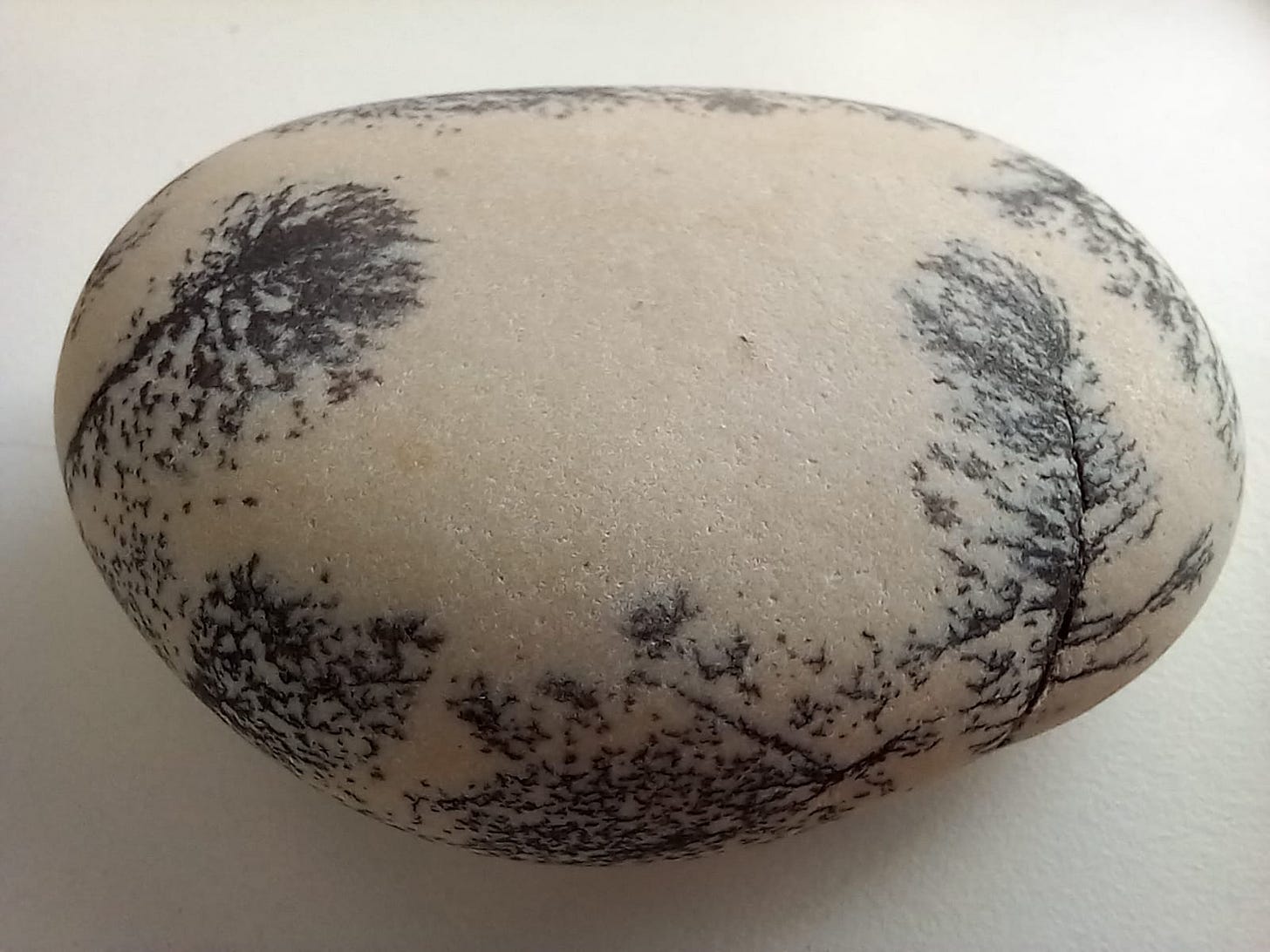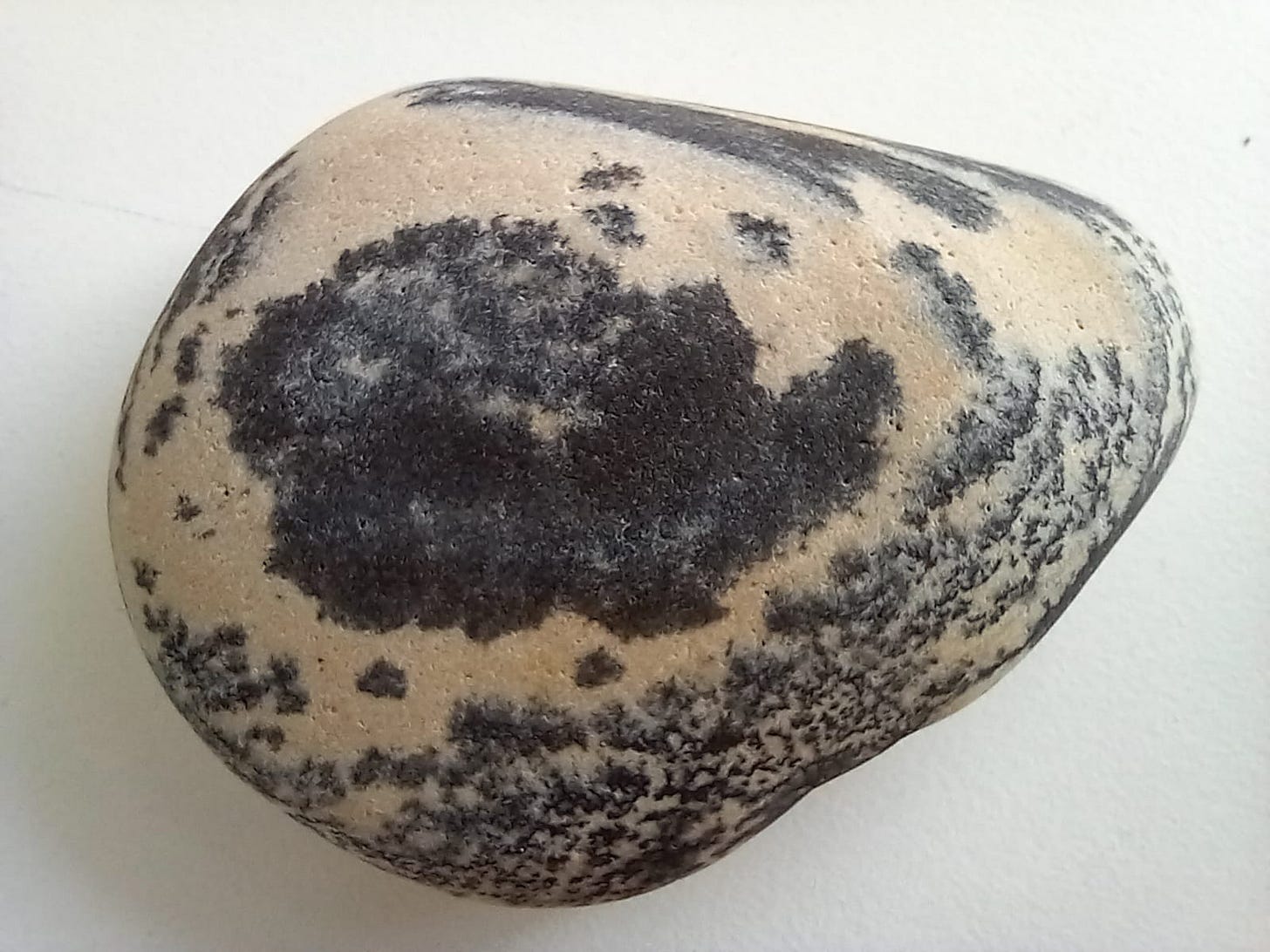Dear friends,
My daughter recently did a unit at school about rocks. As part of it she had to write the story of a stone, from its formation to its ultimate erosion.
She called her protagonist Pablo the Pebble and, in her telling, his life is a bit of a comedy of errors: he’s constantly falling into volcanoes or being spat out of volcanoes or being crushed or bashed or ground up. Throughout, Pablo feels pretty sorry for himself and you can sense that he knows things are only going in one direction. By the time he finally becomes a grain of sand, he’s glad of a rest.
The story is light on geological detail, but it’s quite effective in its own way. It does a good job of thinking in more-than-human timescales, bringing to life the dynamism of landscapes and the impermanence of permanent-looking things.
There’s a beach near our house with an impressive assortment of pebbles, which have all, like Pablo, been on their journeys.
My favourites bear the impressions of fossilised plants. Small smooth time capsules, they fit in your hand and carry the deep past into the present.
Some contain the shapes of miniature trees; some are stippled with what looks like lichen; some are covered with thick mossy smudges. The etchings are meticulous, as though they have been inked onto the stones, an impression deepened by the tattoo-blue colouring.
Any fossil is remarkable – the way it takes something fleeting and sets it in stone, giving it a longevity that books and photos and hard drives can only dream of. (As an aside, how strange to think that today’s plants and animals will become fossils too, to think that you yourself might one day be a fossil. I think of fossils as traces from the past; I never think of present things as future fossils).
What I particularly love about these pebble-fossils is how undisguised they are. They’re just lying there, jostling with the stones at the tide line, offering a pure blast of perspective each time I go to the beach.
I decided to find out what kind of stone this is and why it acquires these imprints.
Rooting around online, I learnt that it’s called Dendritic Jasper. Dendron is the Greek word for tree, dendrites the name we give to the branching tree-forms of nerve cells.
But, as I soon realised, the dendrites in the stone are not fossils.
I felt a pang of disappointment. I kept reading, hopping from tab to tab, sorry that my discoveries were not what I thought they were.
‘In paleontology,’ I read, ‘dendritic mineral crystal forms are often mistaken for fossils. These pseudofossils form as naturally occurring fissures in the rock are filled by percolating mineral solutions […] Pseudofossils may be misleading, as some types of mineral deposits can mimic lifeforms by forming what appear to be highly detailed or organized structures.’
I was clearly not the first to be deceived. There are no plants in the pebbles, only crystals ‘mimicking lifeforms’. In the heat and pressure of the rock’s formation, minerals seep in, spreading and branching the way ice crystals spread across glass.
After sitting with this information for a while, I noticed my disappointment give way to curiosity. The idea of ‘pseudofossils’ is almost stranger than actual fossils. How strange to find plant-like forms in rocks. How strange to find them in the neurons in our bodies. How strange to think that plants grow and branch like crystals and nerve cells, to see the same tendencies and possibilities emerge at such different scales, in such different contexts.
I look at dendritic jasper differently now, but I still appreciate it as a transmission across epochs, a snapshot not of ancient plants but of the moment of the stone’s own making, the moment when it was open and fluid and permeable.
Picking up a pebble and inspecting the patterns on its surface, I feel a sudden connection to vast, head-spinning timescales. Washed up on the shore, like a message in a bottle, it shocks me into awareness.
Warm wishes,
Matt








I love the thought that we and other things/beings are future fossils. And pseudo-fossils! I shall keep my eyes out for these wonderful tricksters!